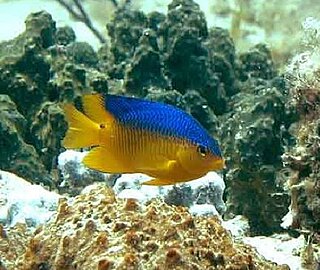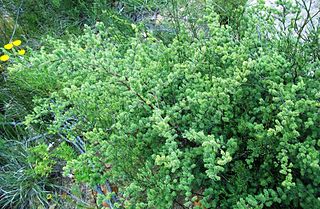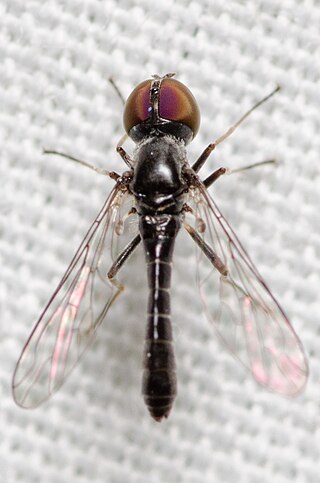
Pomacentridae is a family of ray-finned fish, comprising the damselfishes and clownfishes. This family were formerly placed in the order Perciformes but are now regarded as being incertae sedis in the subseries Ovalentaria in the clade Percomorpha. They are primarily marine, while a few species inhabit freshwater and brackish environments. They are noted for their hardy constitutions and territoriality. Many are brightly colored, so they are popular in aquaria.

The Garibaldi, known historically also as the Catalina goldfish and marine goldfish and now commonly as the Garibaldi damselfish is a species of bright orange fish in the damselfish family. It occurs in the subtropical northeastern part of the Pacific Ocean. The Garibaldi is the official marine state fish of California, as of 1955, and has since been protected in California coastal waters from recreation and commercial fishing.

Halictidae is the second-largest family of bees with nearly 4,500 species. They are commonly called sweat bees, as they are often attracted to perspiration. Halictid species are an extremely diverse group that can vary greatly in appearance. These bees occur all over the world and are found on every continent except Antarctica. Usually dark-colored and often metallic, halictids are found in various sizes, colors and patterns. Several species are all or partly green and a few are red, purple, or blue. A number of them have yellow markings, especially the males, which commonly have yellow faces, a pattern widespread among the various families of bees. The family is one of many with short tongues and is best distinguished by the arcuate basal vein found on the wing. Females in this family tend to be larger than the males. They are the group for which the term 'eusocial' was first coined by entomologist, Suzanne Batra.

Halictus rubicundus, the orange-legged furrow bee, is a species of sweat bee found throughout the Northern Hemisphere. H. rubicundus entered North America from the Old World during one of two main invasions of Halictus subgenera. These invasions likely occurred via the Bering land bridge at times of low sea level during the Pleistocene epoch.

Pallopteridae is a family of flies. The various species are collectively called flutter-wing flies, trembling-wing, or waving-wing flies, because of the striking vibration of the wings in many species. Over 70 species in about 15 genera are found in the temperate regions of the Northern and Southern Hemispheres.
Attenborougharion rubicundus is a species of air-breathing semi-slug, terrestrial pulmonate gastropod molluscs in the family Helicarionidae.

Campiglossa is a genus of fruit flies in the family Tephritidae. There are at least 190 described species in Campiglossa.

Zygaena rubicundus, common name fulvous burnet,. is a species of moth in the family Zygaenidae.

Asparagus rubicundus is a fluffy, thorny shrub of the Asparagus genus, that is endemic to the Cape Provinces of South Africa.
Rubicundus is a genus of hagfishes, the only extant member of the subfamily Rubicundinae. All species in it were formerly classified in Eptatretus. R. eos, R. lakeside, and R. rubicundus are known from single specimens caught in the Tasman Sea, Galápagos, and Taiwan, respectively. They are named after the distinctive red coloration that all species share.
Autumnimiris rubicundus is a species of plant bug in the family Miridae. It is found in Central America and North America.

Tomomyzinae is a subfamily of bee flies in the family Bombyliidae. There are six genera and more than 50 described species in Tomomyzinae.
Paracosmus morrisoni is a species of bee fly in the family Bombyliidae. It is found in Mexico and the southwestern United States from California to Texas.
Paracosmus is a North American genus of bee flies in the family Bombyliidae. There are five described species in Paracosmus.
Agnocoris rubicundus is a species of plant bug in the family Miridae. It is found in Europe and Northern Asia and North America.
Dicropaltum rubicundus is a species of robber flies in the family Asilidae.
Dicropaltum is a genus of robber flies in the family Asilidae. There are about six described species in Dicropaltum.
Paracosmus edwardsii is a species of bee fly in the family Bombyliidae. It is known from California and Utah.
Paracosmus insolens is a species of bee fly in the family Bombyliidae. It is known from California and Nevada.
Rubicundus lakeside, the Lakeside hagfish, is a species of jawless fish in the family Myxinidae.








